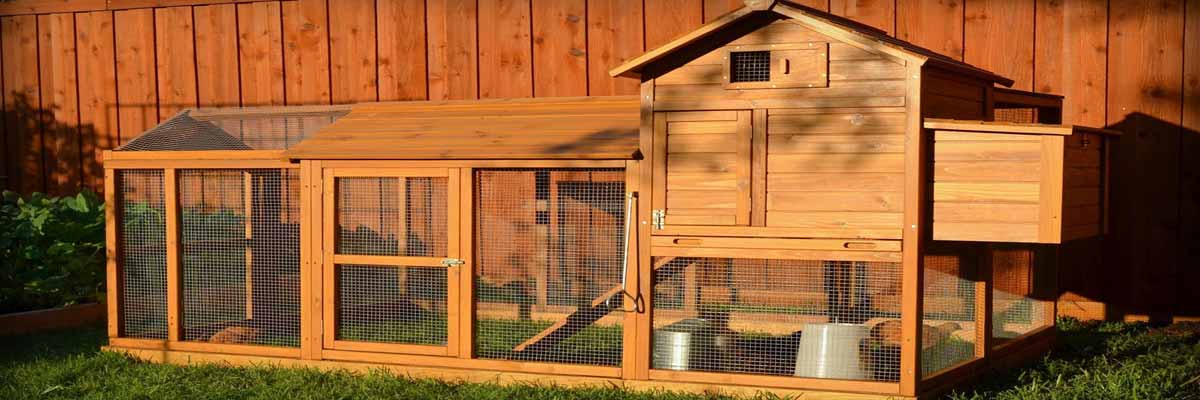Raising Urban Chickens: Part 2-Building a Coop
This is a guest post by Wendy from Home Is… From reading her blog I knew she had chickens, and since she lives in Maine her knowledge of building a coop that will hold up to cold weather could be quite useful. She has written a series of articles on our site before related to her personal decision to stay in her home in the suburbs during the coming descent down Hubbert’s Peak.
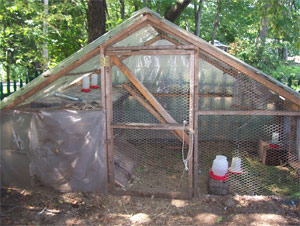
Before I ever made my foray into chicken-ownership, I spent some time researching what I was getting into. Barbara Kilarski’s book, Keep Chickens, was a wonderful resource for everything from choosing a breed to providing information about how big their enclosure needed to be. While my hope was that they would be able to also spend some time free-ranging around the yard, my plan was to build the coop big enough that they could spend all of their time in there, if they had to.
We only have a quarter acre of land, and while my neighbors on either side, who have a half acre and an acre respectively, like my chickens, I didn’t wish to push my luck by letting my chickens loose to roam in their yards. They probably wouldn’t care … much, but as Frost’s neighbor observed in the Mending Wall, “good fences make good neighbors”, and as there is a fence there, it’s probably best that I keep “mine” on this side of it.
In addition, with only a quarter acre, space is a premium, and none can be wasted or under-utilized. Every side of my house has some edible plant or planting bed, especially the south-facing backyard. Chickens can really wreak havoc in a newly planted garden bed. They like to scratch things, and soft, newly planted soil with tasty little seedlings is too much to pass up. Don’t ask me how I know.
Not to mention that during the winter, with several feet of snow on the ground, I knew the chickens wouldn’t be doing much “free ranging”, and so they’d likely spend at least four months cooped up.
The first requirement, therefore, was that it be large enough to allow the chickens room to spread their wings, as it were.
Ms. Kilarski’s book gave me the basic dimensions we needed to ensure that the chickens had enough room, but I spent some time online looking at different designs. We had just come out of a pretty harsh winter. Our driveway isn’t big enough to plow, and so it must be shoveled. In addition to the driveway, which is roughly the size of two large parking spaces, we shovel a path from the road back to the oil and propane tanks, and ever since we moved here, we’ve always had rabbits, and so we’ve always had to shovel a path back to the rabbit cages. Plus, at some point during the winter, the snow just gets too deep for our dogs to squat anymore, and we will usually help them out by shoveling a little place for them to take care of their business. Snow. It’s a real thing here. I knew that my chicken run would have to be covered, because there was no way I was going to be shoveling it out.
Thus, the second requirement was that it have a roof of some sort – something to keep out the snow and to protect the chickens from the rain.
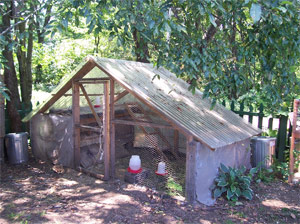
I’m not very handy. I mean, I can drive in a nail or screw in a screw. I can even drill a hole, but … suffice it to say that I’m a “helper” when it comes to construction, and not a very strong one of those. So, I needed my husband’s help with building the coop. The problem was that he was still mad about the fact that we had chickens at all. *We* had never agreed to chickens. They just came home with me one day … from the feed store, where I bought them and all of the brooder supplies. He was not happy.
To compound matters, I don’t control the purse strings, and so, not only was he being forced to build a coop for chickens he never wanted, but he was also going to have to figure out what needed to be bought AND then, pay for it. Oh, he was seriously NOT happy.
The third requirement was that it be cheap and use as many of the various pieces as possible of construction flotsam and jetsam we had lying around the yard from previous projects.
The additional complication was that our “original” design, which I dubbed the “Frankenstein Coop” was decent at keeping the chickens *in*, but poor at keeping critters out. As such, we lost our best laying hen and three pullets to a raccoon. That was tough and necessitated another trip to the feed store for more chickens.
As such, the fourth requirement was that our coop be “predator proof.”
A final consideration in our coop “design” was that it be tall enough that we could walk into it and open enough that my children could go in there and hang out with the chickens, like they like to do.
With all of those requirements in mind, first, we sketched a couple of potential designs. We agreed on a basic framework and got to work.
We had the roof from the “Frankenstein Coop.” The roof was constructed using four eight-foot 2” x 4”s, attaching two together with screws on one end to make two V’s. We attached the two V’s together using 1”x 2”s. Then, we took some corrugated clear plastic roofing and screwed it down on the frame. The roof has a 30° pitch and when it’s sitting on the ground, is about four feet at its peak.
For the sides, we used the top and bottom frame from an old rabbit hutch we had built inside of our once-upon-a-time shed that the Town made us get rid of. The frames are, roughly, eight feet
long and about two feet wide. With the roof attached to the side frames, the peak is about six feet, tapering down to two feet.
The rest of the coop design was, basically, dictated by the side pieces and the roof.
For bought materials, we purchased several more 2” x 4”s, which were used to make the back and front walls and the door. We also purchased fifty feet of 48” chicken wire. This was stapled to the frame all around.
We hammered pieces of 6” plastic edging into the ground to deter digging predators, and it worked.
The hen house is a remodeled rabbit hutch. We removed the front wire and replaced it with bottom-hinging doors. We replaced the wire floor with a piece of plywood. We had to cut off the legs, because it wouldn’t fit into the coop otherwise, and so the “house” is only a foot or so off of the ground, but this works out pretty well, because the “doors” also serve as a sort of “chicken ladder.” When the “ladies” are ready to go to bed at night, they walk up the “door” and into their house. Then, we close and latch the doors until morning.
Inside the house, are four “nesting boxes” and the front frame of each nesting box is a roosting bar. The house is, roughly, seven feet wide by four feet deep, and is about three feet tall on the inside. The hens roost about a foot up from the floor of the house.
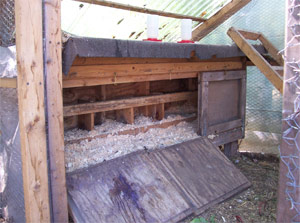
The only real drawback of our house design is that the hens roost right above the nesting boxes, and chickens poop … a LOT, which means the nesting boxes get full of poop. But the hens have figured out a solution – they nest on one side of the house and roost on the other. That way, one nesting box, which they all use, is clean and poop free for laying eggs. Based on this observation, alone, I disagree with the assertion that chickens are stupid, and with the claim that they are “nasty” or “dirty.” They apparently don’t enjoy sitting in poop to lay their eggs.
The only real drawback of the “run” design is that the hens can get under the house and back behind it, and then we can’t reach them. So, far, it’s not been an issue.
Our coop design, as it turns out, was pretty ingenious.
Our backyard is on the southern side of our property. We put the coop in the southwestern most corner of the backyard. In the summer, when we built it, it was under the trees, in the shade, which kept the chickens out of the sun and kept them cool.
That part of our property is all deciduous trees, and as happens here in Maine as the seasons get cooler, the trees lost their leaves. As a result, during the winter, the coop gets full sun all day.
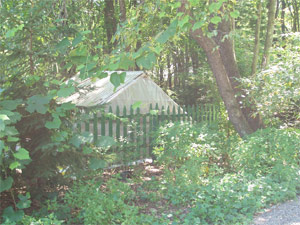
The walls are just a 2”x 4” frame with a wire covering. For years, we’ve housed rabbits outside all year long, and they’ve always been just fine. In the winter, we’ve always wrapped any open parts of their hutches with clear plastic sheathing (like that used by painters as a drop cloth). We did the same for our chickens. The plastic wrapped walls combined with the clear plastic roof and the full day of sun resulted in the ground inside in the coop never freezing – all winter, even when we had weeks of sub-zero nights and below freezing days. On some nights the water would freeze, but the hens would be snug inside their 96 cubic feet, where their bodies would keep each other warm. During the day, when the sun came up, they stayed cozy inside the coop, and on particularly sunny days, the inside temperature of the coop would be as much as 20° warmer than outside the coop. And they could still scratch around on the ground, because the floor of their run is just straw-covered dirt that never froze.
Because it was all enclosed, we never had to shovel, either, although, as with the rabbits, we did have to shovel a path back to the coop, and a couple of times, we had to chip the ice in front of the door so that we could open it.
The final bonus to our coop design was that our chickens continued to lay all winter. We believe it was the combination of natural light and the day time warmth of the coop. In fact, they gave us an average of four eggs per day, all winter, with the oldest hen, Penny, in the middle of her molt in December. This summer, we’ve been lucky to get three eggs per day. Go figure!
We don’t have any electricity in our coop. There are no lights and no heaters, but because of the small hen house, which allows it to be heated with just the chickens’ own body heat, and the solar heating of the coop during the day, we don’t need those things.
Before we built our coop, I spent exhaustive hours scouring the Internet for ideas, and even thought I wanted to buy a kit or a pre-fab coop, but in the end, with the desire to be frugal paramount, what we built was almost divinely inspired … and probably saved us about $150.
And as for my husband, I believe he’s finally made his peace with the chickens. He even feeds them in the morning and tucks them in at night. He’s still hell-bent against getting goats, but I recall seeing some for sale at the feed store not too long ago. Maybe, like the chickens … or a stray kitten … a couple of does will follow me home some day ….
